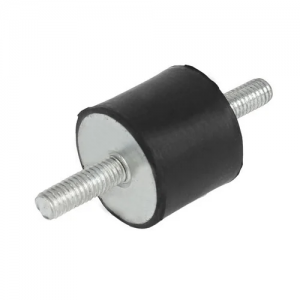A rubber durometer is a measure of the hardness of rubber. The typical scale for softer rubber is Shore A with a range of 0 to 100, with 0 being the softest and 100 being the hardest. Rubber durometer is a simple consideration for vibration dampening because people consider hardness as a measure of the ability of rubber to absorb shock.
Rubber with a higher durometer will typically be less able to absorb shock than rubber with a lower durometer. The reason is that rubber with a higher durometer is more rigid. Therefore, selecting an appropriate durometer for the application is vital when choosing rubber for vibration dampening.
A better understanding of rubber-dampening properties can be gained by looking at the viscoelastic properties of a given compound. The different polymer types provide a better level of dampening based on the polymer structure and chemical chains. During dampening, there is a component of how much energy is stored in a polymer (elastic) and how much energy is dissipated as heat (viscous). Dynamic Mechanical Analysis (DMA) is a standard method for measuring this. A rubber compound undergoes oscillating stress while the resulting strain is recorded. The ratio of dynamic stress to dynamic strain is E* or complex modulus which can be resolved into the storage modulus (E’) and the loss modulus (E”). E’ is the ability of a material to store energy and is related to the stiffness of the rubber. E” is the ability to dissipate heat due to the molecular motions.
Glass Transition (Tg) is vital to dampening rubber because rubber stiffens at cold temperatures and softens at higher temperatures. Thus changes in surrounding air temperatures can change the performance of a rubber dampener based on the polymer.
The following are some tips for choosing the correct rubber durometer for vibration dampening:
- Consider the type of vibration that will be absorbed
- Consider the frequency of the vibration
- Consider the amplitude of the vibration
- Consider the environment in which the rubber will be used
- Load force for the displacement of the rubber
Once you have considered these factors, you can select the suitable rubber durometer for your application.
This paper is a simplified look at different rubber polymers and the change in durometers over a given temperature range.
Durometer at a Given Temperature
We tested six compounds that are typically used for dampening applications. All durometers are Shore A scale.
- 06SL7AP – 70 Silicone – Peroxide Cured
- 01VT7EE – 75 FKM ( 67% Fluorine) – Bisphenol cured
- 18EP7AP – 70 EPDM – Peroxide cured
- 27BN7AP – 70 NBR – Sulfur Cured
- 03BU7AP – 70 Butyl – Sulfur Cured
- 08SL6ML – 70 Liquid Silicone Rubber (LSR) – Platinum cured
Table 1: Gives the durometer reading instantaneous after 30 min exposure to temperature.
| Durometer (Shore A) at Temperature ‘C | |||||
| Compound | D1418 | 0 | 23 | 50 | 100 |
| 06SL7AP | VMQ | 69 | 68 | 66 | 63 |
| 01VT7EE | FKM | 84 | 79 | 75 | 72 |
| 18EP7AP | EPDM | 74 | 71 | 67 | 63 |
| 27BN7AP | NBR | 74 | 70 | 65 | 64 |
| 03BU7AP | IIR | 81 | 75 | 69 | 63 |
| 08SL6ML | VMQ | 60 | 60 | 57 | 58 |
Table 2: Durometer reading after exposure to 50°C, then allowed to be at room temperature, and durometer recorded at given minutes after exposure.
| Durometer (Shore A) After 50’C exposure x Minutes | |||||
| Compound | D1418 | 1 | 5 | 10 | 20 |
| 06SL7AP | VMQ | 67 | 66 | 66 | 67 |
| 01VT7EE | FKM | 76 | 76 | 77 | 78 |
| 18EP7AP | EPDM | 67 | 67 | 68 | 68 |
| 27BN7AP | NBR | 66 | 66 | 67 | 68 |
| 03BU7AP | IIR | 70 | 72 | 74 | 75 |
| 08SL6ML | VMQ | 58 | 58 | 59 | 59 |
Conclusions
This simplified testing does show that the durometer changes in a given temperature range. FKM rubber will harden even at relatively lower temperatures, like 0°C. You can see the durometer starts to increase from 23°C down to 0°C. Butyl rubber typically had a good low-temperature, its performance showed the same. It was interesting to see the drop in durometer at elevated temperatures for NBR and EP compounds. Silicones have a broad operating temperature range which is shown. The LSR-type silicone does seem to perform the best, probably due to the better efficiency of the platinum cure than the peroxide cure.
Ref:
- Ucar H, Basdogan I. Dynamic characterization and modeling of rubber shock absorbers: A comprehensive case study. Journal of Low-Frequency Noise, Vibration, and Active Control. 2018;37(3):509-518. doi:10.1177/1461348417725954
- V G Geethamma, R Asaletha, Nandakumar Kalarikkal and Sabu Thomas. Vibrations and Sound Damping in Polymers. Indian Academy of Sciences. 2014
